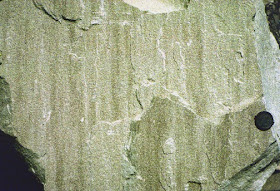A paleocurrent is just what the term implies: a current, of water or wind, that existed at some time in the past.
Cross stratification: Measure the local orientation of laminae in the cross sets, on the theory that the local down dip direction, which presumably is the direction of progradation of the foreset slope, is likely to represent fairly closely the local current direction. That's true, however, only if the bed forms were reasonably two dimensional. If the bed forms were three dimensional, resulting in trough cross stratification, measurement of foreset dip directions at local places in the cross sets can be very misleading; it's much better to try to ascertain the orientation of the trough fills themselves, although it takes good outcrops to do that. Seeing rib and furrow is by far the most reliable way of obtaining a paleocurrent direction from cross-stratified deposits, but unfortunately it’s uncommon to see on outcrop.

Bed forms: If you are lucky enough to see bedding planes covered with symmetrical ripples or dunes, you can get an excellent measurement of current direction.

Clast orientation: Long axes of the larger clasts in a clastic deposit, whether gravel or sand, are commonly oriented by the current, although the orientation may be rather subtle. The problem is that the orientation relative to the current depends on the flow itself in ways not well understood. So beware of clast orientation in and of itself. Pebble imbrication is an exception, and should always be sought in gravels and conglomerates.

Sole marks: Flutes and grooves at the bases of turbidites and other strong current event beds give excellent evidence of the direction of the initial, eroding current. But keep in mind that the later current that did the depositing did not necessarily flow in exactly the same direction.

Parting lineation: Parting lineation is thought to reflect a subtle anisotropy in rock strength caused by a statistical tendency toward alignment of sand grains in a sandstone parallel to the current direction. It gives excellent evidence of the orientation of the current, but unfortunately not the direction.
